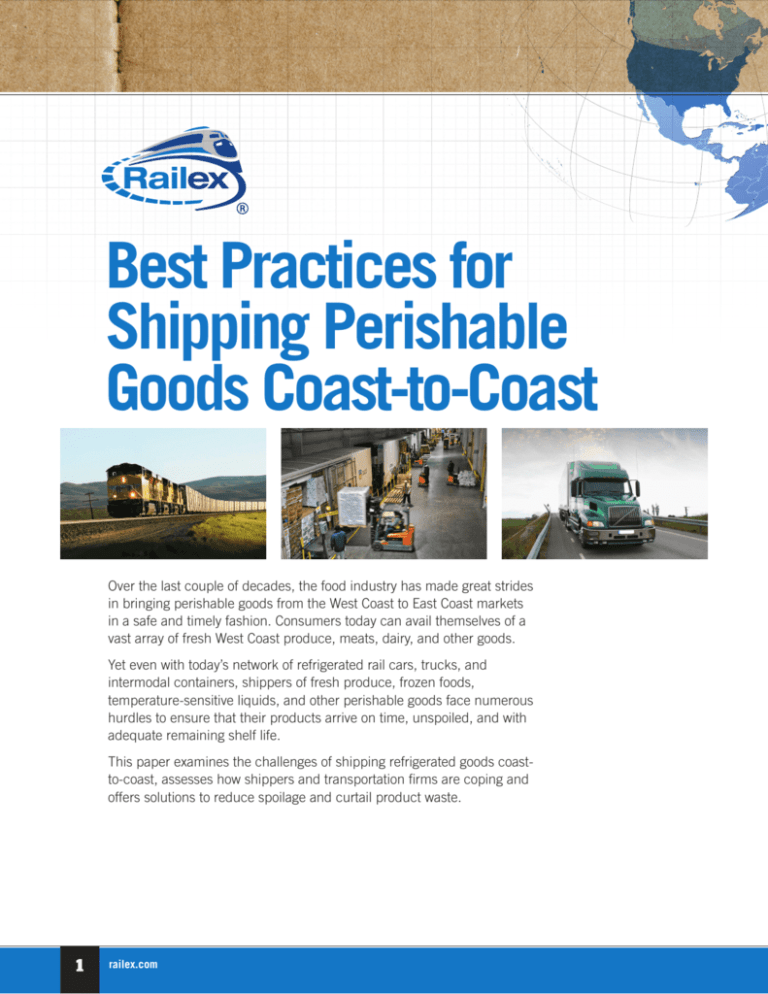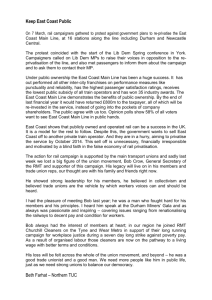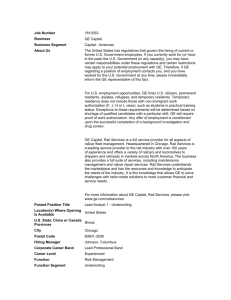Best Practices for Shipping Perishable Goods Coast-to-Coast
advertisement

Best Practices for Shipping Perishable Goods Coast-to-Coast Over the last couple of decades, the food industry has made great strides in bringing perishable goods from the West Coast to East Coast markets in a safe and timely fashion. Consumers today can avail themselves of a vast array of fresh West Coast produce, meats, dairy, and other goods. Yet even with today’s network of refrigerated rail cars, trucks, and intermodal containers, shippers of fresh produce, frozen foods, temperature-sensitive liquids, and other perishable goods face numerous hurdles to ensure that their products arrive on time, unspoiled, and with adequate remaining shelf life. This paper examines the challenges of shipping refrigerated goods coastto-coast, assesses how shippers and transportation firms are coping and offers solutions to reduce spoilage and curtail product waste. 1 railex.com A Rearview Mirror Perspective As recently as the 1980s, East Coast supermarkets typically offered iceberg lettuce, bulk potatoes, packaged carrots, etc. There was little available in the way of fresh produce from California or Washington state growers, despite the fact that these states are among the leaders in production of a variety of fruits and vegetables. “In the U.S. alone, spoilage and waste in the food supply chain result in the loss of 23-25 percent of fruits and vegetables post-harvest.” — ChainLink Research Today, East Coast consumers enjoy the availability of an eye-opening variety of fresh produce, including cantaloupes, asparagus, many types of berries, and an assortment of different lettuces, either loose or in different packaging, each with its own “sell by” date and much more. Clearly, this dramatic change in food shoppers’ purchasing habits didn’t come about overnight, nor on its own without help from another key industry that was undergoing sweeping changes of its own: transportation. Long-haul trucking has been a key driver of this change, but in recent years it has undergone changes of its own that have affected its role in transporting perishables coast-to-coast. Today’s truckers are required to operate under a new set of federal highway safety restrictions that limit the number of hours they can spend behind the wheel each day, as well as the number of shifts (four) before they must take a 36 hour hiatus. Thus, it is much easier for truckers to manage loads being shipped regionally than for them to take on cross-country loads. For instance, a long-haul refrigerated truck transporting perishable produce, meat, or dairy products coast-to-coast would, by necessity, require a stop and/or a change of drivers to complete its journey and avoid delay. These changes, according to one industry prediction, are expected to result in a serious shortage of long-haul truck capacity by 2015. Read More Online. At the same time the food and trucking industries were undergoing change, railbased shipping of cross-country goods became more competitive, largely due to intermodal transport as well as, more recently, the advent of private rail services. Intermodal shipping, which utilizes shipping containers that can be transported via rail, truck, or ocean vessel, expanded rapidly. Produce, liquid and frozen foods can be refrigerated in intermodal shipping containers offering the same ease of transport for perishable goods by rail or by long-haul trucks Yet another option, private rail, offers shippers an economical, dependable service dedicated to bringing fresh produce, wines, and frozen foods from Western U.S. growers and packers to East Coast markets. Unlike ordinary rail service, private trains have the advantage of dedicated, secure rail cars that run on a specified route, on a fixed schedule, reducing the risk of train delays or the possibility of a rail car being diverted. 2 railex.com The Spoilage Problem Regardless of the mode of travel, the cross-country transport of fresh produce, wines, or other perishable goods poses a complex set of problems that, while manageable, often represent significant challenges for shippers. Chief among these is the constant concern over spoilage. At any time in the product’s journey there is the potential for the cold foods to be allowed to reach higher than the adequate temperature essential to maintain freshness. Spoilage, in fact, remains a huge problem for the food industry worldwide. On a global basis, the cost of food spoilage totals more than $35 billion annually, according to a Forbes Magazine report. “When the food thaws and later refreezes, it’s the last person to hold the product who is blamed, even if they had nothing to do with causing the problem.” — Peter Mehring, CEO, Intelleflex In the U.S. alone, spoilage and waste in the food supply chain result in the loss of 23% to 25% of fruits and vegetables post-harvest, according to ChainLink Research. Furthermore, the research firm reports that 25% to 50% of the total economic value is lost because of reduced quality of products in the supply chain. The causes of the spoilage and waste losses are numerous, but ChainLink attributes about half the loss to variations in temperature that occur. The cold chain for fresh foods begins shortly after harvesting, when the fruit or vegetables are taken into a cold storage facility where they are pre-cooled, usually down to 34 degrees F. Pre-cooling is done to remove the natural heat from the product as quickly as possible to avoid any possible spoilage at the packing house. “Cold is the friend of most of these products — if they get around where it is hot, they will continue the spoilage process,” says Jim Prevor, a recognized authority on perishable foods who writes about the produce industry at www.perishablepundit.com. “If you can get a cantaloupe down to 34 degrees F, that gives it extended shelf life.” However, if perishables are not maintained under sufficiently cold conditions, spoilage can result. “The challenge is how to identify when the product is not meeting the cold chain requirements,” says Peter Mehring, CEO at Intelleflex, a San Jose, Calif. company that makes an RFID-based tracking system to monitor the temperature of food shipments in transit. “When the food thaws and later refreezes, it’s the last person to hold the product who is blamed, even if they had nothing to do with causing the problem,” adds Mehring. Often food spoilage is caused by a series of small lapses along the product’s journey, Mehring says, that result in cumulative damage to the product — i.e., either a lack of freshness, or reduced shelf life on arrival at the retailer. 3 railex.com In many cases, however, when a refrigerated truck or container has incurred a lapse of time during which the temperature rose above the cold threshold, such incidents will be detected at the receiving end when the distributor or retailer checks the record of the truck or container’s temperature sensor. Not all rail cars and long-haul trucks come equipped with temperature recording devices, Prevor cautions. “They are not necessarily built into a railcar, but whenever you are shipping using a refrigerated car, you should order one to be placed in it.” In the case of private rail services, the train cars remain intact, with only a new train operator taking over to complete the journey. Some rail and truck shippers are able to avoid the cost of refrigeration by packing fresh foods in insulated blankets. This practice, which can have the unwanted effect of speeding up the aging of foods and beverages, may possibly result in spoilage of the product that can wipe out any potential savings. Another challenge for shippers using LTL (less-than-truckload) shipments via truck is making sure that “incompatible” fruits and vegetables are not paired in proximity where spoilage can occur. For example, ethylene-producing fruits should not be packed with other ethylene-sensitive fruits. For example, shipping honeydew melons that are high in ethylene content along with cantaloupes that are ethylenesensitive can result in faster spoilage of the cantaloupes. These kinds of unfortunate pairings can occur if the truck makes multiple pickups at different packers. Without question, the challenge of ensuring the quality of the “cold chain” requires vigilant management of both people and processes involved in shepherding cold foods throughout the transport journey — from delivery by the packing firm to the shipper’s warehouse, through transport from the West Coast to the East Coast, and on to delivery to the retailer. For many shippers, this means selecting a transportation firm that is resolute in maintaining absolute custody of the product as it moves through the supply chain from one coast to the other, from the packing house all the way to the retailer’s warehouse or shelf. Maintaining The Cold Chain Both conventional rail and truck transport offer refrigerated services that operate coast-to-coast with somewhat similar delivery times of roughly five to seven days. For trucks, the estimated elapsed time in transit also may depend on route and whether the truck is less-than-truckload or a full truckload. Each of these modes of transport, rail or truck (or a combination of both) typically requires a transfer point — usually at a depot or other shipment reconfiguration site in the Midwest — where some spoilage or other waste, due to a break in the cold chain, may occur. 4 railex.com Railex: Solving the Perishables Challenge Consistency and flexibility distinguish Railex from other cross-country transportation services. With warehouses in Delano, Calif., and Wallula, Wash., on the West Coast and Schenectady, N.Y., and Jacksonville, Fla., Railex offers a complete supply chain management service including transportation and logistics for cold food shippers requiring coast-to-coast shipment and delivery. The company puts together four trains weekly, departing from California on Wednesday and Friday afternoons and leaving Washington state the same days in the late evenings. Because Railex operates on a regular schedule with dedicated trains, the service is dependable, enabling five-day, coast-tocoast rail transit. Using 64-foot refrigerated railcars, Railex affords shippers flexibility to handle anything from a single pallet up to thousands of pallets per shipment. Train loads are carefully built to eliminate inadvertent spoilage due to careless packing of pallets with incompatible fruits and vegetables. As a quality control measure, Railex stores and ships mixed commodities in optimal commodity-segregated zones. This allows the private rail service to maintain specific temperature controls for each zone, so that different fruits, vegetables, and other perishable goods are kept at the optimum temperature. continued on next page 5 railex.com For most commercial rail shipments, the eastbound train from the West Coast operated by a Western rail carrier will be reconfigured at a rail consolidation point where the handoff is made to an Eastern rail carrier. There, refrigerated train cars are uncoupled from the initial train and held temporarily until a new full train can be assembled and sent on its way to an Eastern terminus. It is during this remaking of the train that refrigerated goods must be carefully shepherded to ensure that the containers are not left unattended on a siding nor delayed for hours or longer while trains are “made up.” By contrast, in the case of private rail services, the train cars remain intact, with only a new train operator taking over to complete the journey. By not having the train reconfigured, private rail avoids the possibility of a delay or a mix-up resulting in a lost or diverted car. In a similar fashion, long-haul truckers, according to regulation, must stop to rest after no more than four days on the road. For a perishable load, typically two drivers will alternate, with the second driver completing the final leg of the trip to an Eastern U.S. warehouse or distribution facility. Managing Frozen Goods In Transit Because of the high value of some foods being shipped —for example, up to $84,000 worth at retail for a full load of 24 pallets of strawberries — shippers are increasingly depending on various technologies. Indeed, software and hardware can be extremely helpful to shippers seeking to monitor, track, and inspect the quality of produce and other perishables before, during, and at the end of their journey to market. Obviously, every party in the perishable goods supply network — shipper, rail operator or trucking firm, and retailer — has a strong interest in observing best practices in managing the cold chain to ensure food safety and quality. Moreover, federal regulations under the Sanitary Food Transportation Act of 1990 mandate that certain requirements related to food transportation must be followed throughout the supply chain, from shipper, to carrier, to retailer, to guarantee the safety and freshness of food. The private rail service also affords shippers the benefit of third-party logistics-including forward distribution by truck from its warehouses-- that effectively increases its coverage zone. Railex warehouses also serve as product holding zones to enable shippers to exactly meet their customers’ just-in-time delivery requirements. Some transportation services operate a web site or intranet enabling shippers to check the status of their shipment online. “Our intranet system enables customers to sign in and see where the train carrying their shipment is every day,” says Paul Esposito, Executive Vice President for Network Planning and Government Relations at Railex, which operates a twice-weekly dedicated train service delivering West Coast produce and other perishables to East Coast distribution facilities. “All our refrigerated train cars are monitored by GPS.” “Railex offers a new way to get produce shipped securely and economically,” says Jim Prevor, who writes about the produce industry at www.perishablepundit.com. Choose A Transportation Platform Wisely “The problem with most trains is that their delivery schedules are unreliable,” Prevor says. “You may have a train that gets delayed or a rail car that is diverted. But with a dedicated train like Railex, you avoid that problem. Railex has the advantage of dedicated rail cars on a specified route, that go on a fixed schedule.” Although commercial rail services may offer the most economical service, most trains typically do not make a direct trip from the Western coast states to Eastern cities such as Boston, New York, Washington, Atlanta, or Miami. Trains are remade at various locations, with the possibility that a shipment could undergo a delay of a day or two. For more information visit Railex.com Clearly, the choice of a transportation service — whether it is via rail or truck — is critical for cross-country shippers of perishable goods or frozen foods. While coast-to-coast truck services may offer a speedier service, some shippers may be reluctant to entrust their products to a driver or drivers who, for whatever reason, may make an unscheduled stop along the way. Or in the case of an LTL (less-than-truckload) shipment, they may be scheduled to make an additional pickup or two to make a full load prior to embarking on the trip eastbound, breaking the cold chain in the process. . In sum, shippers would be wise to research the various options available for transporting perishable goods, wine, and other frozen foods coast-to-coast so they can make the best choice based on cost, dependability, and the ability to maintain the cold chain. 6 railex.com





